Tricity Bendix DH 103 User Manual

INSTRUCTION BOOK
Dishwasher
DH 103
 1 06/03
1 06/03
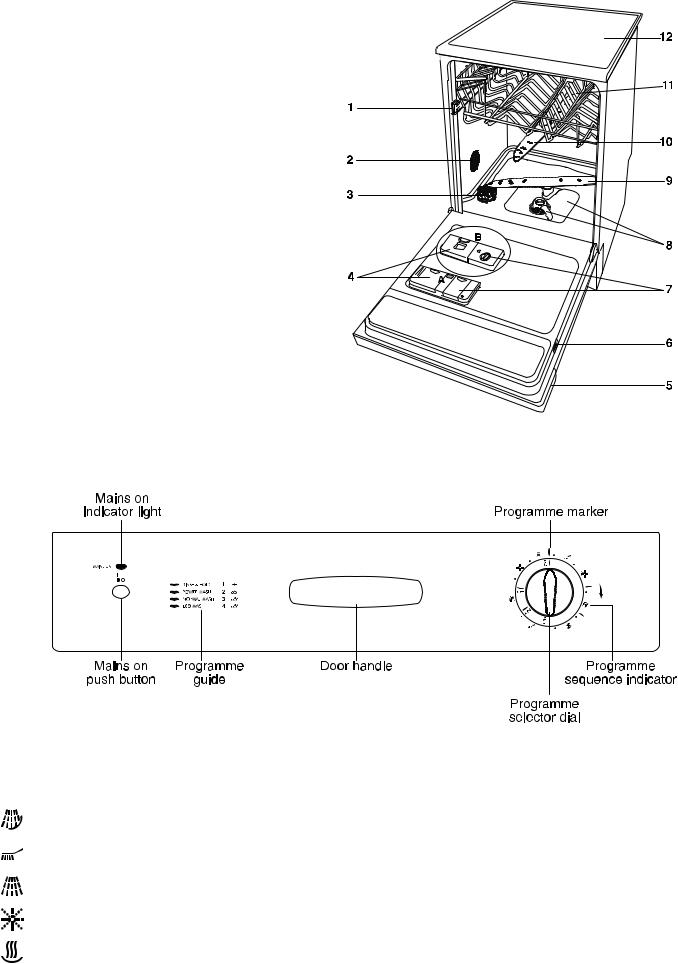
Description of the appliance
1.Upper basket stop
2.Water hardness switch
3.Salt container
4.Detergent dispenser (type A / type B)
5.Control panel
6. Rating plate
7.Rinse aid dispenser (type A / type B)
8.Filters
9.Lower spray arm
10. Upper spray arm
11.Upper basket
12.Worktop
IN148
The control panel
Programme sequence indicator: as the programme progresses, the programme selector dial turns, to show the phase in the wash programme the appliance has reached.
Prewash / Rinse and Hold
Main wash
Cold rinse
Hot rinse
Drying
2
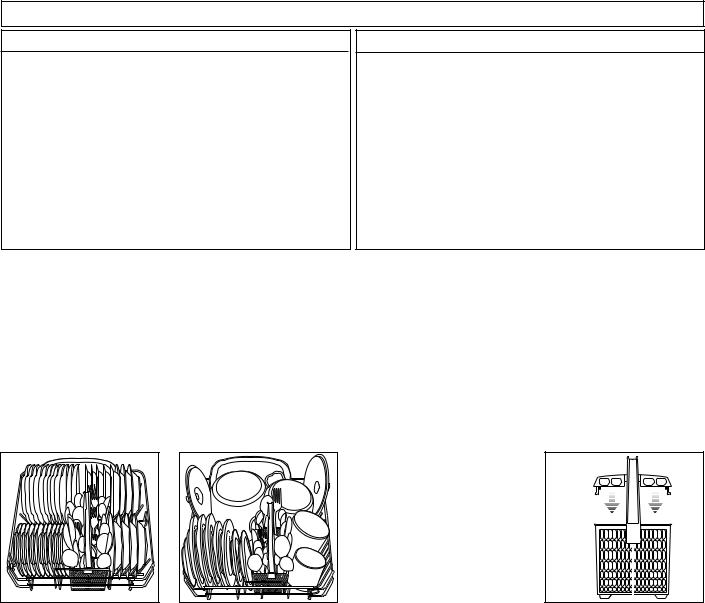
In daily use
●Check if it’s necessary to refill with special salt or rinse aid
●Load cutlery and dishes into the dishwasher.
●Fill with dishwasher detergent .
●Select a wash programme suitable for the cutlery and dishes.
●Start the wash programme.
Loading cutlery and dishes
Sponges, household cloths and any object that can absorb water may not be washed in the dishwasher.
●Before loading the dishes, you should:
-Remove large left-overs.
-Soften remnants of burnt food in pans
●When loading the dishes and cutlery, please note:
-Dishes and cutlery must not impede the rotation of the spray arms .
-Load hollow items such as cups, glasses, pans, etc. with the opening downwards so that water cannot collect in the container or a deep base.
-Dishes and items of cutlery must not lie inside one another, or cover each other.
-To avoid damage to glasses, they must not touch.
-Lay small objects in the cutlery basket.
●Plastic items and pans with teflon have a tendency to retain water drops; these items will not dry as well as porcelain and steel items.
For washing in the dishwasher the following cutlery/dishes
are not suitable:
-Cutlery with wooden, horn, china or mother-of-pearl handles
-Plastic items that are not heat resistant
-Older cutlery with glued parts that is not temperature resistant
-Bonded cutlery items or dishes
-Pewter or copper items
-Lead crystal glass
-Steel items subject to rusting
-Wooden platters
-Items made from synthetic fibres
are of limited suitability:
-Only wash stoneware in the dishwasher if it is specifically marked as being dishwasher-safe by the manufacturer.
-Glazed patterns may fade if machine washed frequently
-Silver and aluminium parts have a tendency to discolour during washing. Left-overs, e.g. egg white, egg yolk and mustard often cause discolouring and staining on silver.
Therefore always clean left-overs from silver immediately, if it is not to be washed straight after use.
-Some types of glass can become dull after a large number of washes
Open the door and slide out the baskets to load the dishes.
The lower basket
The lower basket is designed to take saucepans, lids, plates, salad bowls, cutlery etc.
Serving dishes and large lids should be arranged around the edge of the basket, ensuring that the upper spray arm can turn freely.
UI49 |
UI19 |
The cutlery basket
Long bladed knives stored in an upright position are a potential hazard.
Long and/or sharp items of cutlery such as carving knives must be positioned horizontally in the upper basket.
Take care when loading or unloading sharp items such as knives.
Cutlery should be placed in the removable cutlery basket with the handles facing downwards. If the handles protrude from the bottom of the basket, obstructing the lower spray arm, load the cutlery with the handles facing upwards.
Mix spoons with other cutlery to prevent them from sticking together.
For best results we recommend you to use the cutlery grid provided (if the size and dimensions of the cutlery allow it).
UI71
3
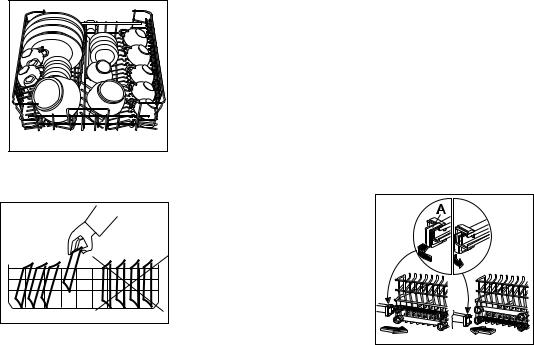
The upper basket
The upper basket is designed for plates (dessert plates, saucers, dinner plates of up to 24 cm in diameter), salad bowls, cups and glasses.
Arrange items on and underneath the cup rack so that water can reach all surfaces.
Glasses with long stems can
be placed upside down in the cup rack. Light items (plastic bowls
etc.) must be loaded in the upper basket and arranged so they do not move.
US64
In case that plates are loaded in the upper basket:
load them starting from the rear positions of the basket; tilting them slightly forwards and avoiding the front positions near the door.
US71 |
Before closing the door, ensure that the spray arms can rotate freely.
Adjusting the height of the upper basket
If washing very large plates you can load them in the lower basket after moving the upper basket to the higher position.
|
Maximum height of the dishes in |
|
|
upper basket |
lower basket |
|
|
|
|
|
|
With upper basket raised |
20 cm |
31 cm |
|
|
|
With upper basket lowered |
24 cm |
27 cm |
|
|
|
To move to the higher position proceed as follows:
1.Move the front runner stops (A) of the upper basket outwards and slide the basket out.
2.Refit the basket in the higher position and replace the stops
(A) in their original position.
RC01 |
After loading your machine always close the door, as an open door can be a hazard.
4
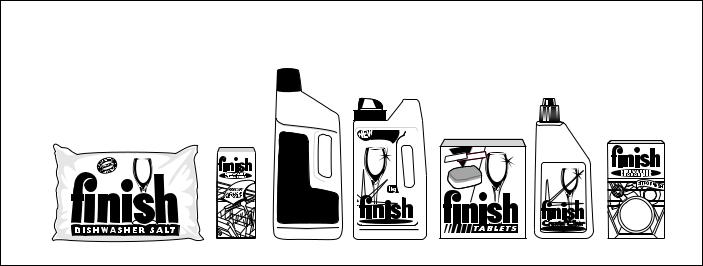
Washing programmes
Programme |
Type of load |
Starting position |
Cycle |
(3) Consumption values |
||||
|
and |
of the |
description |
|
|
|
|
|
|
Programme |
Energy |
Water |
|||||
|
degree of soil |
programme |
|
|||||
|
|
duration |
consumption |
consumption |
||||
|
|
selector dial |
|
(in minutes) |
(in kWh) |
(litres) |
||
|
|
|
|
|
|
|
|
|
|
Any. |
|
1 cold rinse (to avoid |
|
|
|
|
|
|
Partial load (to be |
|
|
|
|
|
|
|
RINSE & HOLD |
|
food scraps from |
12 |
|
0,1 |
|
10 |
|
1 |
|
|
||||||
completed later in |
|
|
||||||
|
|
sticking together). |
|
|
|
|
|
|
|
|
|
|
|
|
|
||
|
the day). |
|
|
|
|
|
|
|
|
|
|
|
|
|
|
|
|
|
|
|
|
|
|
|
|
|
|
|
|
Cold prewash |
|
|
|
|
|
(1) POWER WASH |
Heavy soil. |
|
Main wash up to 65°C |
|
|
|
|
|
|
110 - 120 |
|
1,15 - 1,24 |
|
16 - 18 |
|||
2 |
1 cold rinse |
|
|
|||||
65° |
Crockery, cutlery, |
|
|
|
|
|
||
pots and pans |
|
1 hot rinse |
|
|
|
|
|
|
|
|
|
|
|
|
|
||
|
|
|
Drying |
|
|
|
|
|
|
|
|
|
|
|
|
|
|
NORMAL WASH |
Normal soil. |
|
Main wash up to 65°C |
|
|
|
|
|
|
1 cold rinse |
|
|
|
|
|
||
|
95 - 105 |
|
1,15 - 1,24 |
|
13 - 15 |
|||
3 |
|
|
||||||
65° |
Crockery and cutlery |
1 hot rinse |
|
|
||||
|
|
|
|
|
|
|||
|
|
|
Drying |
|
|
|
|
|
|
|
|
|
|
|
|
|
|
(2) ECO WASH |
Fresh soil. |
|
Main wash up to 65°C |
|
|
|
|
|
|
30 - 40 |
|
1,05 - 1,15 |
|
11 - 13 |
|||
4 |
|
|
||||||
Crockery and cutlery |
1 hot rinse |
|
|
|||||
|
|
|
|
|
|
|
||
|
|
|
|
|
|
|
|
|
(1)Testing programme for EN 50242 (see "Hints for Test Centres).
(2)Ideal for washing crockery and cutlery of breakfast and dinner (fresh soil). Characterised by a short duration.
This is the perfect daily programme, made to meet the needs of a family of 4 persons who only wish to load breakfast and dinner crockery and cutlery.
(3)The consumption values are intended as a guide and depends on the pressure and the temperature of the water and also by the variations of the power supply.
For best results we recommend the use of Finish detergents, rinse aid and salt.
EASY
POURING
PACK
L I Q U I D G E L
P O W D E R
EW |
|
|
N |
DOUBLE |
ACTIO |
|
R I N S E |
C O N C E N T R AT E D D I S H WA S H E R D E T E R G E N T |
|
DE15
5
Starting a washing programme
1.Check that the baskets have been loaded correctly and that the spray arms can rotate freely
2.Turn on the water tap
3.Close the dishwasher door
4.Setting and starting the programme
Turn the programme selector dial clockwise until the letter of the programme you wish to select corresponds with the programme marker on the control panel (see "Washing programmes" chart).
Depress the "Mains on" push button; the "Mains on" indicator light will come on and the machine will start.
5. Interrupting a washing programme
Interrupt a washing programme in progress ONLY if it’s absolutely necessary
To interrupt a washing programme
Attention! Hot steam may escape when the door is opened. Open the door carefully.
●Open the dishwasher door; the programme will stop. Close the door; the programme will start from the point in which it was interrupted.
●Press the On/Off push button (in this case the On/Off indicator light turns off). Press the On/Off push button again; the programme will start from the point in which it was interrupted.
6.End of the washing programme
The dishwasher will automatically stop.
Switch off the dishwasher by pressing the "Mains on" push button, the "Mains on" indicator light turns off. Open the door and wait a few minutes before removing the dishes; in this way they will be cooler and the drying will be improved.
Water may appear on the sides and the door of the dishwasher as the stainless steel will eventually become cooler than the dishes.
Unloading the dishwasher
Hot dishes are sensitive to knocks. The dishes should therefore be allowed to cool down before removing from the appliance.
Empty the lower basket first and then the upper one; this will avoid water dripping from the upper basket onto the dishes in the lower one.
When the washing programme has finished, it is recommended that the dishwasher is unplugged and the water tap turned off.
6
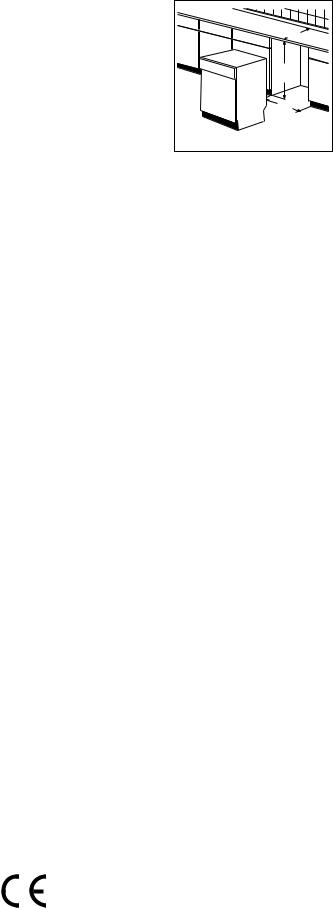
Fitting under a counter
(kitchen worktop or sink)
By removing the machine’s worktop, you can install it under a close fitting sink unit or a pre-existing top, providing the dimensions of the recess correspond to those shown in the picture.
570 |
- |
|
600 |
820 |
|
600 |
|
IN05 |
|
Proceed as follows:
Remove the machine’s worktop by unscrewing the two rear retaining screws, pull from the front and slide out the rear slots, lifting the worktop.
Insert the machine after adjusting height and levelling with the adjustable feet. When inserting the machine, ensure that the water inlet and drain hoses are not kinked or squashed.
If the dishwasher is later used as a free-standing appliance, the original worktop must be re-mounted.
The plinth on free-standing appliances is not adjustable.
Levelling
Good levelling is essential for correct closure and sealing of the door.
When the appliance is correctly levelled, the door will not catch on either side of the cabinet.
If the door does not close correctly, loosen or tighten the adjustable feet until the machine is perfectly level.
Technical specifications
Dimensions |
Width |
60 cm |
|
Height with worktop |
85 cm |
|
Height without worktop |
82 cm |
|
Max depth |
61 cm |
|
|
|
Electrical connection: |
Information on the electrical connection is given on the rating plate on the |
|
Voltage |
inner edge of the dishwasher’s door on the right. |
|
Overall power |
|
|
Fuse |
|
|
|
|
|
Water supply connection: |
|
cold water |
|
|
|
Water supply pressure: |
Maximum |
50 kPa (0.5 bar) |
|
Maximum |
800 kPa (8 bar) |
|
|
|
Capacity |
|
12 place settings |
|
|
|
This appliance complies with the following E.E.C. Directives:
-73/23 or 19.2.73 (Low Voltage Directive) and subsequent modifications;
-89/336 or 3.5.89 (Electromagnetic Compatibility Directive) and subsequent modifications.
7
Service and Spare Parts
In the event of your appliance requiring service, or if you wish to purchase spare parts please contact your local Service Force Centre by telephoning:
08705 929929
Your telephone call will be automatically routed to the Service Force centre covering your post code area.
For the address of your local Service Force Centre and further information about Service Force, please visit the website at www.serviceforce.co.uk
Before calling out an engineer, please ensure you read the details under the heading Something not working.
When you contact the Service Force Centre you will need to give the following details:
1.Your name, address and post code
2.Your telephone number
3.Clear and concise details of the fault
4.The model and serial number (found on the rating plate)
5.The purchase date
Please note that a valid purchase receipt or guarantee documentation is required for in-guarantee service calls.
For Customer Service in Ireland please contact us at the address below:
Tricity Bendix
Electrolux Group (Irl) Ltd
Long Mile Road
Dublin 12
Republic of Ireland
Tel: + 353 (0)1 4090752
Email: service.eid@electrolux.ie
Customer Care
Department
For general enquiries concerning your Tricity Bendix appliance or for further information on Tricity Bendix products please contact our Customer Care Department by letter or telephone at the address below.
Customer Care Department
Tricity Bendix
55-77 High Street
Slough
Berkshire
SL1 1DZ
Tel: 08705 950950 (*)
* calls to this number may be recorded for training purposes
8
